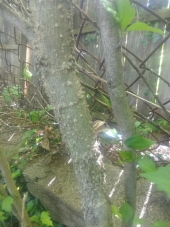
 1
1




 2
2





Invasive plants are Earth's way of insisting we notice her medicines. Stephen Herrod Buhner
Everyone learns what works by learning what doesn't work. Stephen Herrod Buhner
 1
1




A build too cool to miss:Mike's GreenhouseA great example:Joseph's Garden
All the soil info you'll ever need:
Redhawk's excellent soil-building series





 1
1




“Action on behalf of life transforms. Because the relationship between self and the world is reciprocal, it is not a question of first getting enlightened or saved and then acting. As we work to heal the earth, the earth heals us.” ~ Robin Wall Kimmerer
 1
1




Heather Sharpe wrote: Interesting you don't have hackberries there. Where I live, you can't stop them from growing. Very abundant. I wonder why they aren't so present where you are.








William Bronson wrote:Those of you who have hackberries, are the leaves rough to the touch?
“It’s said war—war never changes. Men do, through the roads they walk. And this road—has reached its end.”
 2
2




How strange. I'm surprised they were able, not to mentioned confused as to why. They're wonderful trees. Good on you for working to bring them back!D Tucholske wrote:People killed them all a long time ago & I guess they never managed to make their way back here, yet. It's kind of funny, because I saw an extremely accurate range map of where they grow & where the trees are reported goes in a huge circle around northeast Ohio & western PA.
The ones where I live are quite rough to the touch. My partner has become mildly obsessed with figuring out how to eat them as greens, since they're very abundant. But the rough texture is a little unpleasant on the mouth. Pressure cooking reduces it. Apparently, they're extremely nutritious. Really a rather pleasant flavor to me.William Bronson wrote:Those of you who have hackberries, are the leaves rough to the touch?
“Action on behalf of life transforms. Because the relationship between self and the world is reciprocal, it is not a question of first getting enlightened or saved and then acting. As we work to heal the earth, the earth heals us.” ~ Robin Wall Kimmerer
 2
2








Me either, until recently. The entire fruit and seed is edible too. Lots of protein. The fruity part is very thin, but quite tasty. I guess you can grind the entire seed, fruit and all to use for food. Haven't experimented with that yet, so we shall see. If nothing else, I bet they make good chicken food. Good idea with the dehydrating! Will have to try that!William Bronson wrote:Wow, thank you!
I think I have a few of these trees, but I never knew they had even marginally edible leaves.
Dehydration can fix unpleasant tastes and textures in many leaves.
“Action on behalf of life transforms. Because the relationship between self and the world is reciprocal, it is not a question of first getting enlightened or saved and then acting. As we work to heal the earth, the earth heals us.” ~ Robin Wall Kimmerer
 1
1




 1
1








William Bronson wrote:Here are two photos from my church sisters yard.
The leaves seem to be alike to one another, but the sickly looking ones are from a mature tree.
The photo showing bark is from the mature tree.
Are these Hackberry trees?
“Action on behalf of life transforms. Because the relationship between self and the world is reciprocal, it is not a question of first getting enlightened or saved and then acting. As we work to heal the earth, the earth heals us.” ~ Robin Wall Kimmerer
 1
1









|
He baked a muffin that stole my car! And this tiny ad:
Freaky Cheap Heat - 2 hour movie - HD streaming
https://permies.com/wiki/238453/Freaky-Cheap-Heat-hour-movie
|





